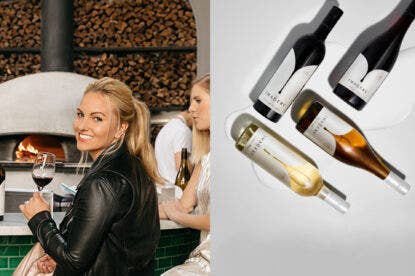Small-batch bottlings typically fetch the highest price tags and most critical praise in today’s wine world. That makes sense, as focused bottlings of less than 1,000 cases tend to best express a particular vineyard and/or a vintner’s winemaking style.
But any experienced winemaker will quickly tell you that it’s much more difficult to make large quantities of wine at a consistent quality year after year.
“It’s one of the best challenges,” says Matt Steel, winemaker at Edna Valley Vineyards, which was founded by the Niven family, who began planting vines back in 1973, and was acquired by Gallo in 2011. Steel knows all about small-batch winemaking, once working at a single-vineyard property in Australia. He continues to make limited-release bottlings for Edna Valley Vineyards, like the Heritage Chardonnay.
“That wine makes itself from the vineyard,” says Steel, who merely has to pick at the right time from the right block and give a “little bit of encouragement” to make a great wine.
But the process is a bit different for the 300,000-plus cases of Central Coast Chardonnay, which blends fruit from San Luis Obispo, Monterey and Santa Barbara counties.
“There are so many more pieces that contribute to the overall blend,” says Steel. “It’s a far more intellectual challenge.”
Like a chef, Steel must know what each ingredient will contribute to the final blend. Sometimes, he will “completely exaggerate” certain lots by picking ripe and letting the grapes go through a vigorous malolactic fermentation to create a rich wine.
“It’s a caricature of the wine and will fall over by itself,” says Steel. “But in a blend, it fills a spot.”
And a hands-on approach is still critical at this level.
“We’re all over them,” he says of the many lots that become part of the Central Coast blend, “and quite fastidious.”
Up the coast in the Arroyo Seco region of Monterey County, Kristen Barnhisel is quickly learning the differences between small- and big-batch production as the new head of white winemaking for J. Lohr.
The Sonoma County native’s background includes a master’s degree from University of California, Davis, work in Italy and South Africa, and jobs at Jordan, Inglenook and Handley in Mendocino County, where she oversaw extremely small lots of wine.
“The difference is really just volume,” she says while walking around J. Lohr’s brand-new, 100,000-square-foot facility constructed for white-wine production.
More than 2,700 tons of fruit came through the facility in 2015. Barnhisel expects that amount to double this year, producing more than 1.6 million cases, the bulk being Chardonnay. But despite that massive flow of juice, she says, “we have a chance to taste it all.”
Aside from that strict attention to detail, technology plays a key role in maintaining consistency and raising quality at J. Lohr. All the latest gadgets are at play, including a system that analyzes the sugar-loading potential of individual grapes—a more accurate measure of potential alcohol than a brixometer.
“There’s an endless curiosity here,” says Barnhisel, who’s encouraged by owner Jerry Lohr and his family to experiment with techniques, tool and ideas.
Such encouragement is a big reason that Jackson Family-owned Cambria Winery in the Santa Maria Valley has produced one of the most popular lines of affordable Chardonnay and Pinot Noir in California for decades.

Winemaker Denise Shurtleff started here in 1999, and founders Jess Jackson and Barbara Banke provided her the resources to make the best wines she could. That enthusiasm for quality continued as the brand steadily grew to its current annual output of 150,000 cases, 100,000 of which is its Benchbreak Chardonnay.
“The family has allowed us to produce wine the same way we produced wine when we were much smaller,” said Shurtleff one recent morning while overlooking the 1,600 acres of vines that surround the winery. “They expect us to be innovative, to try new things and to make the best wine we can.”
But Shurtleff believes there are other keys to making large amounts of good quality wine, particularly the control that comes from having the winery and vineyards in one place. Another factor is staffing consistency. At Cambria, the average employee has been around for nearly 20 years, including two members of the cellar crew who are celebrating their 26th year this vintage.
Like Barnhisel and Steel, Shurtleff also oversees many boutique-level bottlings for her brand, providing them dual perspectives in winemaking. But Shurtleff believes there’s a distinct competitive advantage to managing larger production programs, as it provides a much more nuanced sense of the property.
“I love it,” she says. “It’s small-lot production that gets blended. It really helps us to know our vineyard better.”
Last Updated: May 4, 2023















